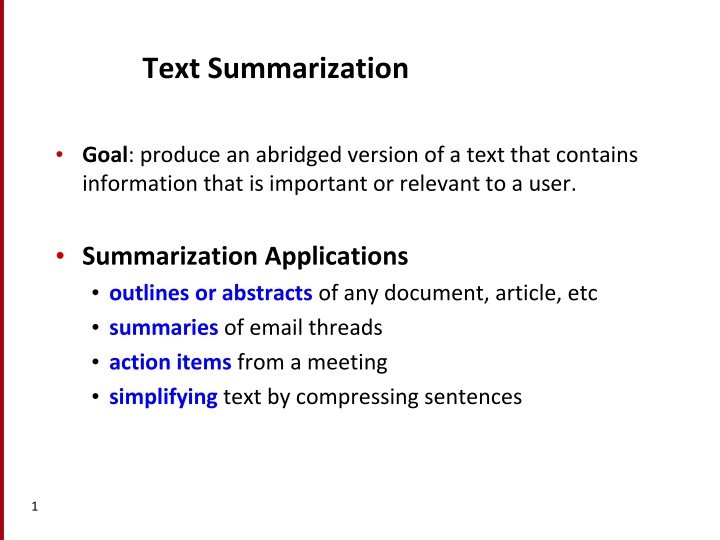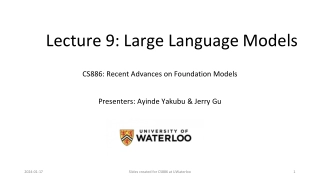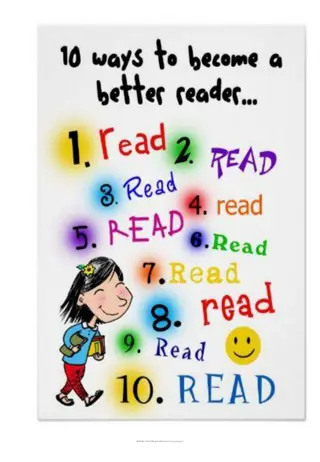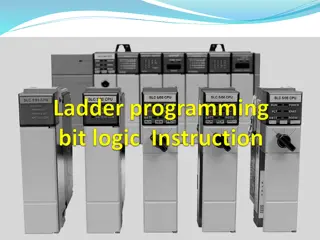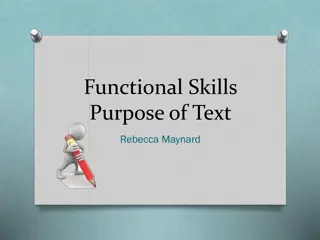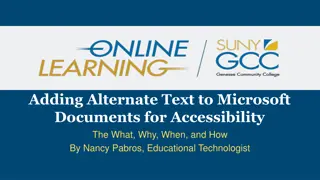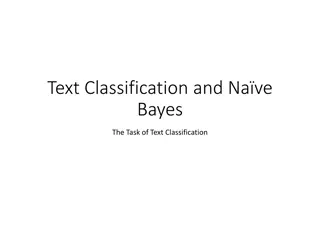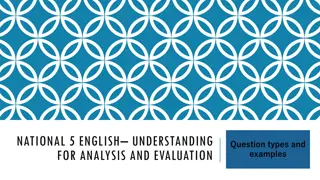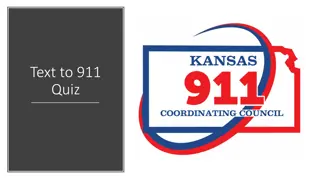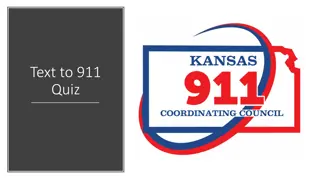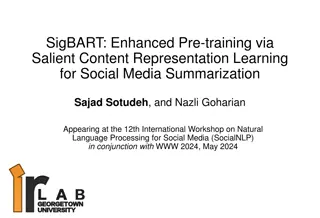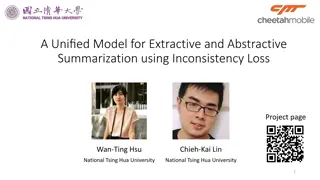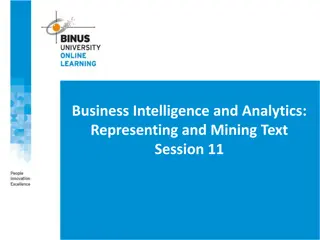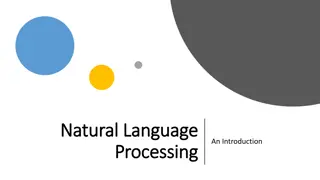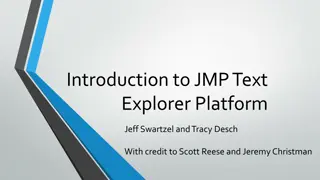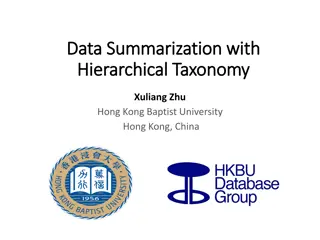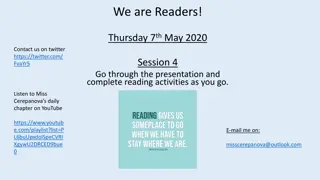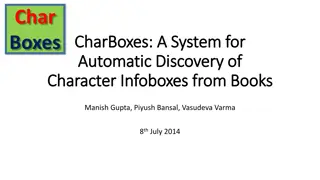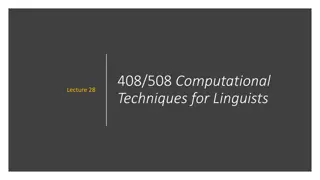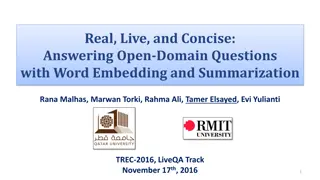Text Summarization
Text summarization involves condensing information from a document into a concise version. It can be applied to single or multiple documents, query-focused tasks, and question answering. The process can be extractive or abstractive, with the goal of simplifying text while retaining essential information.
Download Presentation

Please find below an Image/Link to download the presentation.
The content on the website is provided AS IS for your information and personal use only. It may not be sold, licensed, or shared on other websites without obtaining consent from the author.If you encounter any issues during the download, it is possible that the publisher has removed the file from their server.
You are allowed to download the files provided on this website for personal or commercial use, subject to the condition that they are used lawfully. All files are the property of their respective owners.
The content on the website is provided AS IS for your information and personal use only. It may not be sold, licensed, or shared on other websites without obtaining consent from the author.
E N D
Presentation Transcript
Text Summarization Goal: produce an abridged version of a text that contains information that is important or relevant to a user. Summarization Applications outlines or abstracts of any document, article, etc summaries of email threads action items from a meeting simplifying text by compressing sentences 1
What to summarize? Single vs. multiple documents Single-document summarization Given a single document, produce abstract outline headline Multiple-document summarization Given a group of documents, produce a gist of the content: a series of news stories on the same event a set of web pages about some topic or question 2
Query-focused Summarization & Generic Summarization Generic summarization: Summarize the content of a document Query-focused summarization: summarize a document with respect to an information need expressed in a user query. a kind of complex question answering: Answer a question by summarizing a document that has the information to construct the answer 3
Summarization for Question Answering: Snippets Create snippets summarizing a web page for a query Google: 156 characters (about 26 words) plus title and link 4
Summarization for Question Answering: Multiple documents Create answers to complex questions summarizing multiple documents. Instead of giving a snippet for each document Create a cohesive answer that combines information from each document 5
Extractive summarization & Abstractive summarization Extractive summarization: create the summary from phrases or sentences in the source document(s) Abstractive summarization: express the ideas in the source documents using (at least in part) different words 6
ROUGE (Recall Oriented Understudy for Gisting Evaluation) Lin and Hovy 2003 Intrinsic metric for automatically evaluating summaries Based on BLEU (a metric used for machine translation) Not as good as human evaluation But much more convenient (and some correlation with humans) Given a document D, and an automatic summary X: 1. Have N humans produce a set of reference summaries of D 2. Run system, giving automatic summary X 3. What percentage of the bigrams from the reference summaries appear in X? s {RefSummaries} min(count(i,X),count(i,S)) bigrams i S ROUGE-2= count(i,S) 8 s {RefSummaries} bigrams i S
A ROUGE example: Q: What is water spinach? Human 1: Water spinach is a green leafy vegetable grown in the tropics. Human 2: Water spinach is a semi-aquatic tropical plant grown as a vegetable. Human 3: Water spinach is a commonly eaten leaf vegetable of Asia. System answer: Water spinach is a leaf vegetable commonly eaten in tropical areas of Asia. ROUGE-2 = 3 + 3 + 6 = 12/28 = .43 10 + 9 + 9 9
Summarization: Three Stages 1. content selection: choose sentences to extract from the document 2. information ordering: choose an order to place them in the summary 3. sentence realization: clean up the sentences Extracted sentences All sentences from documents Summary Sentence Realization Document Information Ordering Sentence Segmentation Sentence Extraction Sentence Simplification Content Selection 10
Basic Summarization Algorithm 1. content selection: choose sentences to extract from the document 2. information ordering: just use document order 3. sentence realization: keep original sentences Extracted sentences All sentences from documents Summary Sentence Realization Document Information Ordering Sentence Segmentation Sentence Extraction Sentence Simplification Content Selection 11
Unsupervised content selection H. P. Luhn. 1958. The Automatic Creation of Literature Abstracts. IBM Journal of Research and Development. 2:2, 159-165. Intuition dating back to Luhn (1958): Choose sentences that have salient or informative words Two approaches to defining salient words 1. tf-idf: weigh each word wi in document j by tf-idf weight(wi) =tfij idfi 2. topic signature: choose a smaller set of salient words mutual information log-likelihood ratio (LLR) Dunning (1993), Lin and Hovy (2000) if -2logl(wi)>10 otherwise 1 0 weight(wi) = 12
Supervised content selection Given: a labeled training set of good summaries for each document Align: the sentences in the document with sentences in the summary Extract features position (first sentence?) length of sentence word informativeness, cue phrases cohesion Train a binary classifier (put sentence in summary? yes or no) Problems: hard to get labeled training data alignment difficult performance not better than unsupervised algorithms So in practice: Unsupervised content selection is more common
Complex definition questions: summarizing multiple documents Q: What is water spinach? A: Water spinach (ipomoea aquatica) is a semi-aquatic leafy green plant with long hollow stems and spear- or heart- shaped leaves, widely grown throughout Asia as a leaf vegetable. The leaves and stems are often eaten stir-fried flavored with salt or in soups. Other common names include morning glory vegetable, kangkong (Malay), rau muong (Viet.), ong choi (Cant.), and kong xin cai (Mand.). It is not related to spinach, but is closely related to sweet potato and convolvulus.
Medical questions Demner-Fushman and Lin (2007) Q: In children with an acute febrile illness, what is the efficacy of single medication therapy with acetaminophen or ibuprofen in reducing fever? A: Ibuprofen provided greater temperature decrement and longer duration of antipyresis than acetaminophen when the two drugs were administered in approximately equal doses. (PubMedID: 1621668, Evidence Strength: A)
Other complex questions Modified from the DUC 2005 competition (Hoa Trang Dang 2005) 1. How is compost made and used for gardening (including different types of compost, their uses, origins and benefits)? 2. What causes train wrecks and what can be done to prevent them? 3. Where have poachers endangered wildlife, what wildlife has been endangered and what steps have been taken to prevent poaching? 4. What has been the human toll in death or injury of tropical storms in recent years? 16
Answering harder questions: Query-focused multi-document summarization The (bottom-up) snippet method Find a set of relevant documents Extract informative sentences from the documents Order and modify the sentences into an answer The (top-down) information extraction method build specific answerers for different question types: definition questions biography questions certain medical questions
Query-Focused Multi-Document Summarization a Document Document Query Extracted sentences All sentences plus simplified versions Document Document Document Input Docs All sentences from documents Sentence Extraction: LLR, MMR Sentence Segmentation Sentence Simplification Content Selection Sentence Realization Information Ordering Summary 18
Simplifying sentences Zajic et al. (2007), Conroy et al. (2006), Vanderwende et al. (2007) Simplest method: parse sentences, use rules to decide which modifiers to prune (more recently a wide variety of machine-learning methods) Rajam, 28, an artist who was living at the time in Philadelphia, found the inspiration in the back of city magazines. appositives Rebels agreed to talks with government officials, international observers said Tuesday. attribution clauses The commercial fishing restrictions in Washington will not be lifted unless the salmon population increases [PP to a sustainable number]] PPs without named entities For example , On the other hand , As a matter of fact , At this point initial adverbials 19
Maximal Marginal Relevance (MMR) Jaime Carbonell and Jade Goldstein, The Use of MMR, Diversity-based Reranking for Reordering Documents and Producing Summaries, SIGIR-98 An iterative method for content selection from multiple documents Iteratively (greedily) choose the best sentence to insert in the summary/answer so far: Relevant: Maximally relevant to the user s query high cosine similarity to the query Novel: Minimally redundant with the summary/answer so far low cosine similarity to the summary sMMR=maxs Dlsim(s,Q) - (1-l)maxs Ssim(s,S) Stop when desired length 20
LLR+MMR: Choosing informative yet non-redundant sentences One of many ways to combine the intuitions of LLR and MMR: 1. Score each sentence based on LLR (including query words) 2. Include the sentence with highest score in the summary. 3. Iteratively add into the summary high-scoring sentences that are not redundant with summary so far. 21
Information Ordering Chronological ordering: Order sentences by the date of the document (for summarizing news).. (Barzilay, Elhadad, and McKeown 2002) Coherence: Choose orderings that make neighboring sentences similar (by cosine). Choose orderings in which neighboring sentences discuss the same entity (Barzilay and Lapata 2007) Topical ordering Learn the ordering of topics in the source documents 22
Domain-specific answering: The Information Extraction method a good biography of a person contains: a person s birth/death, fame factor, education, nationality and so on a good definition contains: genus or hypernym The Hajj is a type of ritual a medical answer about a drug s use contains: the problem (the medical condition), the intervention (the drug or procedure), and the outcome (the result of the study).
Information that should be in the answer for 3 kinds of questions
Architecture for complex question answering: definition questions S. Blair-Goldensohn, K. McKeown and A. Schlaikjer. 2004. Answering Definition Questions: A Hybrid Approach. The Hajj, or pilgrimage to Makkah [Mecca], is the central duty of Islam. More than two million Muslims are expected to take the Hajj this year. Muslims must perform the hajj at least once in their lifetime if physically and financially able. The Hajj is a milestone event in a Muslim's life. The annual hajj begins in the twelfth month of the Islamic year (which is lunar, not solar, so that hajj and Ramadan fall sometimes in summer, sometimes in winter). The Hajj is a week-long pilgrimage that begins in the 12th month of the Islamic lunar calendar. Another ceremony, which was not connected with the rites of the Ka'ba before the rise of Islam, is the Hajj, the annual pilgrimage to 'Arafat, about two miles east of Mecca, toward Mina "What is the Hajj?" (Ndocs=20, Len=8) Definition Creation Document Retrieval Sentence clusters, Importance ordering 9 Genus-Species Sentences The Hajj, or pilgrimage to Makkah (Mecca), is the central duty of Islam. The Hajj is a milestone event in a Muslim's life. The hajj is one of five pillars that make up the foundation of Islam. ... 11 Web documents 1127 total sentences Data-Driven Analysis Predicate Identification 383 Non-Specific Definitional sentences
